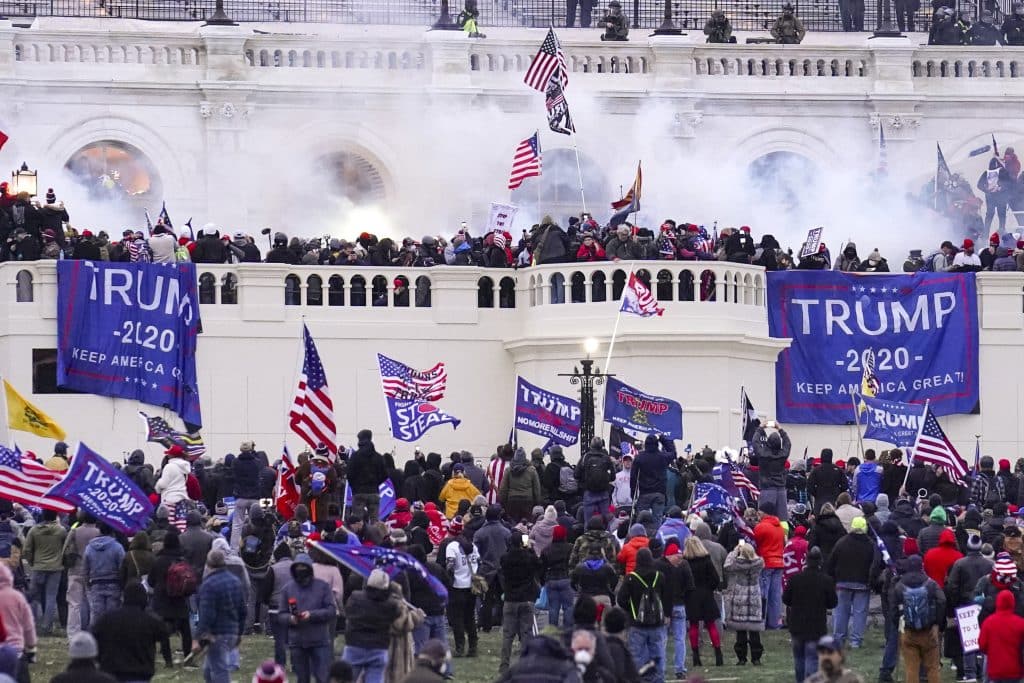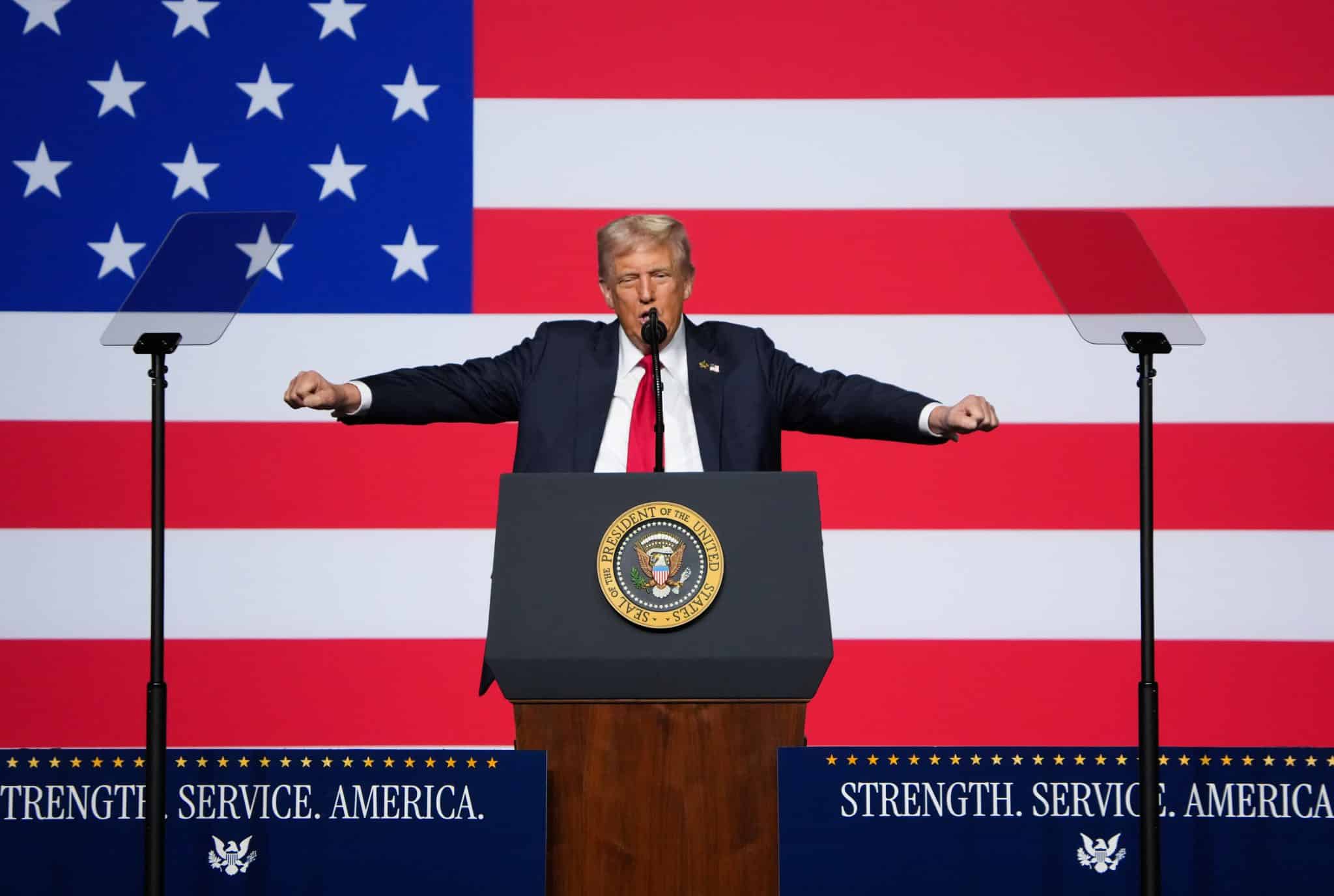During Donald Trump’s first term, his critics widely agreed that the President wanted to be an autocratic strongman, but there was no consensus on the darker, more anxious question: is this fascism? As scholars of the history of American fascism and antifascism, we were often asked to weigh in.
Outside the MAGA base, there is widespread agreement that the country is heading in “authoritarian” directions, and the charge of “fascism” is still readily found on signs at No Kings protests, if not in The New York Times. So what do we call the direction we’re moving in now? Is it fascism, or something else?
Before we answer that, we need to stop and reflect on the question, what is fascism? And, as a disclaimer, every scholar of fascism will give you a slightly different definition.
Our working definition is this: fascism is a kind of right-wing politics. It’s driven by a project of national renewal based around race, militarized masculinity, and violence. To get us back to its mythic past, fascism paradoxically wants radical cultural transformation and radically transformed institutions under authoritarian leadership. Like other forms of authoritarianism, it seeks to erode civil and personal liberties, and is often accompanied, in its early phases, by paramilitary force on the streets, as with the Brownshirts of Germany or Blackshirts of Italy. As such, fascism is also a specific type of authoritarianism (authoritarian regimes can be on the right, the left, or even the center). Its base, furthermore, is almost always middle class and lower middle class, though it draws in elements from other classes too.
Also, fascism is different from mere conservatism, which is more comfortable with slower, incremental change around establishment institutions that is led by the current ruling class (be it the aristocracy, the church, or capitalists, depending on the national context). Conservatism may or may not be authoritarian. Historically speaking, fascists aren’t terribly interested in tax cuts or privatization, though they will deliver both as they form alliances with establishment conservatives and the rich. For fascists, economics are a means to an end; unlike for many conservatives, it isn’t their passion. But to be clear, in the most famous, historical fascist regimes, fascists could not have achieved and held power without enablement and support from establishment conservatives. Fascism grows within capitalist states where a ruling and/or business class decides to ally with “tougher” allies to resolve a crisis or maintain profitability.
INTERVIEW: The History of Fascism and Anti-Fascism in America, with Bill Mullen and Christopher Vials
There have been mercifully few fascist regimes – Germany, Italy, Japan, and Spain – though not all scholars agree on that list. But, virtually every country in the world, including the United States, has been home to fascist movements. And these movements persisted long after the defeat of the Axis in World War II. As Oxford historian Roger Griffin wrote back in 1993, “…as a political ideology capable of spawning new movements [fascism] should be treated as a permanent feature of modern political culture.”
The question among scholars, in other words, is not if fascism survived after 1945, it’s how.
In U.S. history, we’ve already had major, even mainstream movements that can be considered “functional equivalents” of fascism. These would include the “Second” Ku Klux Klan of the 1920s, the “Christian Front” around Father Charles Coughlin in the 1930s, the movement around George Wallace and the American Independent Party in the late 1960s and early 1970s, and elements of the Christian Right, particularly its “reconstructionist” wing. In this country, they typically don’t openly identify with the fascist label, and, in the past, they never created a fascist government, though they did move politics and even institutions in that direction. Never before, however, have any of these movements been centered around the charisma of a strongman, presidential candidate capable of winning elections and enacting their authoritarian ambitions on a broad scale.
So now we come to MAGA.

We define MAGA as an “aspirational” fascist regime. By this we mean that its tactics, strategies and policies endeavor to include, incorporate or advance a politics that is recognizably “fascist” by either a classical or contemporary definition. Put another way, the Trump regime seeks to move the state further and further to the right on a one-way political vector whose logic is fascist.
For example, Trump launched his new state by pardoning and commuting the sentences of the January 6th rioters, many of whom were open fascists. He began an assault on labor—a classical fascist tactic—firing thousands of unionized federal employees and stripping nearly half a million of union protections. He built out and ramped up ICE, the Border Patrol and Homeland Security as infrastructures of domestic repression followed by the construction of internment camps (Alligator Alcatraz) to house deportees. He has expanded police powers and definitions of criminality beyond existing legal breaking points — a hallmark of classical fascist states like Germany and Italy. For example, he has assembled a laundry list of “internal enemies” (a phrase Nazi jurist Carl Schmidt famously used to describe Third Reich policy) ranging from lawyers to professors to dissidents.
Trump’s Big Beautiful Bill has massively reduced an already meager U.S. social welfare system while directing hundreds of billions of new dollars to the military and domestic policing, while he has openly boasted of American cities as “training grounds” for war. Indeed, Trump has deployed national guard troops to Los Angeles, Portland, Chicago, Memphis and Washington D.C. and called for citizen “volunteers” to join ICE and Homeland Security in a round-up of so-called criminals and illegals. Recruitment efforts for these volunteers have used white nationalist imagery and nativist appeals to “defend your homeland” or “defend your culture.” Finally, Trump’s Vice President JD Vance and his DOGE Czar Elon Musk have courted parties like the German ADF, widely regarded in their home countries as fascist.
Trump has also rolled out a fascist cultural politics. This includes calls to rebuild and reinstall white supremacist monuments, eliminate “divisive” exhibits from American museums showing civil rights history, redefine race as a biological category, erase Trans people, and punish anyone who asserts that there are more than two genders. Trump’s climate denialism, attacks on alternative energy sources and dedication to fossil capitalism likewise comport with what has been called eco-fascist ideology.
In addition, the Trump administration has absorbed and replicated tactics commonly associated with “street” fascism. We are seeing far less paramilitary activity by organizations like the Proud Boys in this second Trump administration, mainly because the federal government itself is offering similar outlets now as paid and pensioned jobs. Most obvious is the deployment of ICE, Homeland Security, National Guard and policing agents on the streets to arrest, intimidate, harass or otherwise provoke citizens and non-citizens. Explaining why they are no longer so visible these days, Enrique Tarrio, chairman of the Proud Boys recently said, “Things we were doing and talking about in 2017 that were taboo, they’re no longer taboo — they’re mainstream now. Honestly, what do we have to complain about these days?”
Parts of the MAGA base, to be clear, also now openly identify as “fascist,” particularly its younger members. This includes not only the alt-right of Trump 1.0, but, now, mostly notably, Nick Fuentes and his online army of “groypers” which the Oval Office has become increasingly anxious about. Individuals from the first Trump administration who were fired for attending a “white nationalist” conference or who were deemed too toxic because of openly Nazi statements are now part of the administration. As was revealed in an expose from Politico just this week, Young Republican leaders from around the country, on track to become national leaders in the Party, were joking with each other in highly racist, homophobic online chats about sending their opponents to the gas chambers.
In the broader MAGA cultural sphere, major right-wing influencers like Tucker Carlson have even started to break taboos surrounding Adolf Hitler. The most radical variants of the “Great Replacement Theory” have also become common in MAGA realms. For those unfamiliar with it, the Great Replacement is the idea that international Jews have conspired to replace white people with hordes of nonwhite immigrants in their own “homelands,” a particularly dangerous conspiracy that has inspired mass shootings from Buffalo to El Paso.
For all these moves, we still call Trump 2.0 “aspirational fascism” because this administration and their enablers have still not converted the United States into a fully authoritarian state. Many democratic legal and political norms remain, though they are imperiled as never before. Rival political parties can still operate out in the open and there are still many spaces – including this one – to criticize the federal government.
Can aspirational fascism become fully-realized fascism?
That is the question of our time. What is clearly required in the current moment is a revival of an equally important but forgotten tradition of American antifascism. Often forgotten is this country’s own long and distinguished history on this count. American antifascism began on a national scale with the Popular Front in the 1930s, which drew in figures from Humphrey Bogart to Ernest Hemingway and linked the fight against fascism abroad to domestic campaigns around labor rights and racial justice. It continued in the 1950s in the successful agitation against McCarthyism; and it emerged again in the 1960s when the Black Panther Party fought against incipient mass incarceration under the banner of antifascism. Indeed, one more symptom of MAGA’s aspirational fascism is its recent executive order designating “antifa” as a “domestic terrorist organization.” As most everyone knows, “antifa” is not an organization at all. Trump’s attempt to wipe out antifascist organizing of all kinds is merely an attempt to further “clear the ground” for authoritarianism. In a moment such as this, we best buckle down and fight back. As Fred Hampton once put it, “Nothing is more important than stopping fascism, because fascism will stop us all.”






